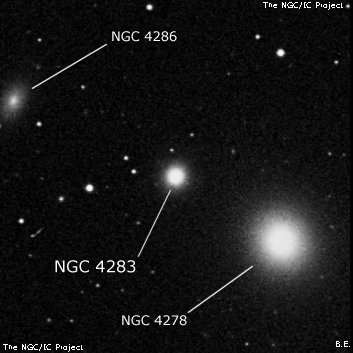
William Herschel discovered NGC 4283 = H II-377 = H II-323 = h1188 on 13 Mar 1785 (sweep 387) and recorded II-323 as "Three [with NGC 4278 and 4286], all in a row, but of unequal size and brightness. The most following [NGC 4286] vF." His single position is 14 sec of time following NGC 4278. He found NGC 4283 again a month later (11 Apr), assumed it was new and recorded II-377 as "Two [with NGC 4283], the time is that of the brightest and preceding NGC 4278], which is cB, pL, nearly R. The other [NGC 4283] is sf [error: should read nf], pB, S, about 6' distance." JH made two observations and measured an accurate position.
400/500mm - 17.5" (4/25/98): moderately bright, round, 1' diameter. Fairly well concentrated with a small, bright core and stellar nucleus. Second of three in trio with brighter NGC 4278 3.5' SW and NGC 4286 5' NE. Poor transparency due to smoke.
Notes by Steve Gottlieb